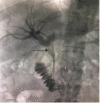Intractable Biliary Candidiasis in Patients with Obstructive Jaundice and Regional Malignancy: A Retrospective Case Series
- PMID: 33707962
- PMCID: PMC7941053
- DOI: 10.2147/CEG.S301340
Intractable Biliary Candidiasis in Patients with Obstructive Jaundice and Regional Malignancy: A Retrospective Case Series
Abstract
Background: Candida species are infrequently grown in bile cultures. An association between biliary candidiasis and regional malignancy may exist. The role of fungus membranes in frequent biliary stent occlusion is also presented in this case series.
Methods: We retrospectively identified patients who underwent percutaneous trans-hepatic cholangiogram (PTC) for obstructive jaundice between January 2014 and January 2019. The results of bile cultures - obtained by PTC - for all patients were analyzed, and patients with fungus growth were determined; their medical records were reviewed.
Results: A total of 71 patients with obstructive jaundice underwent PTC between January 2015 and January 2019. Five patients (all male; mean age 55.8 years) had candida species growth in bile cultures. Two patients were diagnosed with cholangiocarcinoma, one with adenocarcinoma of the head of the pancreas, one with gallbladder cancer, and one with locally advanced gastric adenocarcinoma. Formation of fungal balls predisposed to frequent PTC drain clogging. Eradication of Candida was achieved in 4 patients after 10 days to 3 weeks of antifungal therapy.
Conclusion: We present a case series of biliary candidiasis in patients with obstructive jaundice and regional malignancy. We suggest that patients with obstructive jaundice and regional malignancy should be screened for biliary candidiasis. Persistent cholestasis may be caused by the recurrent formation of fungal membranes (balls).
Keywords: Candida; PTC; biliary; cholangiocarcinoma; obstructive jaundice.
© 2021 Al manasra et al.
Conflict of interest statement
The authors report no conflicts of interest for this work.
Figures


Similar articles
-
Improving biliary stent patency for malignant obstructive jaundice using endobiliary radiofrequency ablation: experience in 150 patients.Surg Endosc. 2022 Mar;36(3):1789-1798. doi: 10.1007/s00464-021-08457-3. Epub 2021 Mar 31. Surg Endosc. 2022. PMID: 33788032
-
Locally advanced pancreatic carcinoma with jaundice: the benefit of a sequential treatment with stenting followed by CT-guided 125I seeds implantation.Eur Radiol. 2021 Sep;31(9):6500-6510. doi: 10.1007/s00330-021-07764-6. Epub 2021 Feb 25. Eur Radiol. 2021. PMID: 33630162 Free PMC article.
-
Percutaneous transhepatic cholangiography and intraductal radiofrequency ablation combined with biliary stent placement for malignant biliary obstruction.J Vasc Interv Radiol. 2015 May;26(5):715-21. doi: 10.1016/j.jvir.2015.01.037. Epub 2015 Mar 24. J Vasc Interv Radiol. 2015. PMID: 25817458
-
Cystic duct patency in malignant obstructive jaundice. An ERCP-based study relevant to the role of laparoscopic cholecystojejunostomy.Ann Surg. 1995 Mar;221(3):265-71. doi: 10.1097/00000658-199503000-00008. Ann Surg. 1995. PMID: 7536405 Free PMC article. Review.
-
Cholangitis due to candidiasis of the extra-hepatic biliary tract.HPB Surg. 1998;11(1):51-4. doi: 10.1155/1998/75730. HPB Surg. 1998. PMID: 9830582 Free PMC article. Review.
Cited by
-
A Challenging Case of Biliary Obstruction in an 82-Year-Old Male With a History of Zollinger-Ellison Syndrome and Suspected Cholangiocarcinoma Secondary to Biliary Candidiasis.Cureus. 2025 Jan 16;17(1):e77551. doi: 10.7759/cureus.77551. eCollection 2025 Jan. Cureus. 2025. PMID: 39958098 Free PMC article.
-
Environmental and Lifestyle Risk Factors in the Carcinogenesis of Gallbladder Cancer.J Pers Med. 2022 Feb 8;12(2):234. doi: 10.3390/jpm12020234. J Pers Med. 2022. PMID: 35207722 Free PMC article. Review.
References
LinkOut - more resources
Full Text Sources
Other Literature Sources

